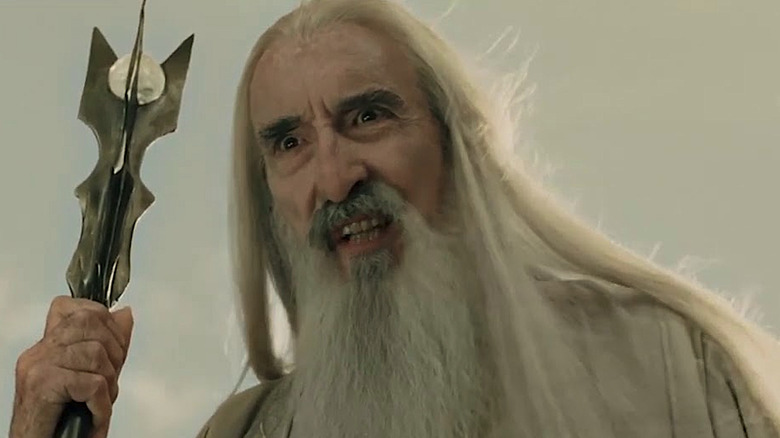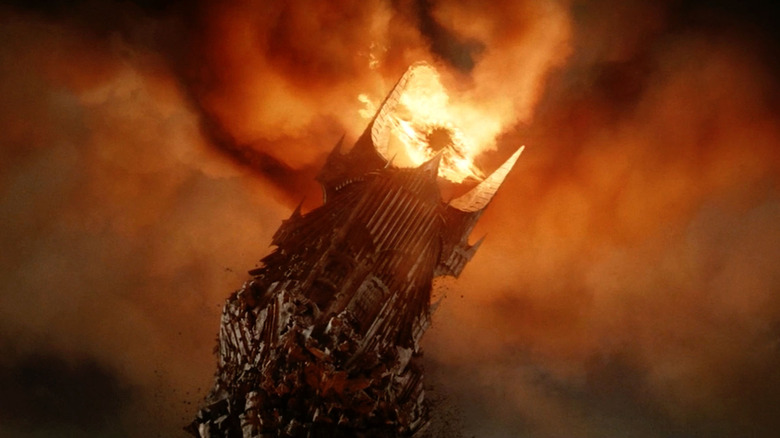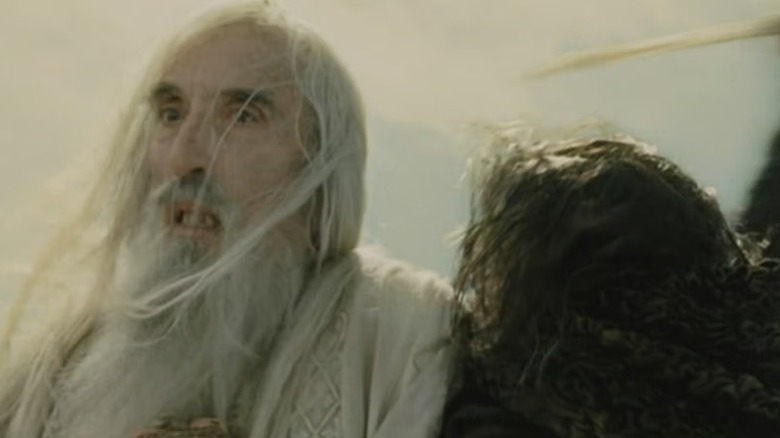What Happens To Saruman At The End Of Lord Of The Rings Is Worse Than Death
It's hard to tell who really dies and who doesn't in "The Lord of the Rings." The Elves pass away overseas to the Undying Lands in the West. Gandalf falls to his doom and then comes back stronger than ever. Boromir really does perish, mown down by Orc arrows. Gollum dies too, tripping to his death at the Cracks of Doom. And Saruman? He doesn't die. His body is killed, and his spirit lingers on, empty and insignificant.
Technically speaking, the fate of Saruman varies depending on your Middle-earth experience. Those who only watched the theatrical versions of Peter Jackson's films likely don't have an answer to the question. The last you see of Saruman is the Wizard trapped by Ents in his tower of Orthanc at the end of "The Two Towers." Anyone who watched the lengthy extended editions of "The Lord of the Rings" movies will know that, in a previously deleted scene, Saruman is stabbed by Wormtongue (Brad Dourif), dramatically falls from the top of his tower, and is pierced on a spiked water wheel-looking device, which slowly turns, burying the Wizard in a watery grave. (The fact that this scene was cut from the beginning of "The Return of the King" literally caused Saruman actor Christopher Lee to snub the movie's premiere.)
Book readers know that both the unfinished and dramatically morbid on-screen endings are actually aberrations from J.R.R. Tolkien's source material. They're also too neat and tidy a resolution for the kind of being Saruman is. In reality, Saruman doesn't die like a Human or an Orc. Sure, his body is stabbed by Wormtongue, but this actually happens in the Shire (yes, you read that right), and Saruman doesn't perish after he's shuffled off this mortal coil. His spirit lingers on, defeated, trivial, and ultimately irrelevant — a reality that, for the ambitious Wizard, is a fate worse than death.
Sauron's death sets the tone for Saruman's death
How does Saruman's life continue after his body dies? Like the Dark Lord Sauron, Saruman is a Maiar — J.R.R. Tolkien's version of an angelic spirit. As one of Tolkien's unique "uppercase W" Wizards, Saruman is also an incarnate Maiar tasked with the mission of resisting Sauron in Middle-earth. However, both before and after their task, the Wizards can live without the need for physical forms.
So, what happens to a Maiar after their physical form perishes? We get a glimpse of this when Sauron bites the dust but doesn't die at the end of "The Return of the King." Right after the One Ring is destroyed, Tolkien wrote, "There rose a huge shape of shadow, impenetrable, lighting-crowned, filling all the sky. Enormous it reared above the world, and stretched out towards them a vast threatening hand, terrible but impotent: for even as it leaned over then, a great wind took it, and it was all blown away, and passed; and then a hush fell." That is the final picture of Sauron.
Earlier in the book, Gandalf adds that when the One Ring is destroyed, "[Sauron] will be maimed for ever, becoming a mere spirit of malice that gnaws itself in the shadows, but cannot again grow or take shape." So Sauron doesn't die. He merely becomes a marginalized and insignificant spirit trapped outside of time and space. (He literally ends up in a place called the Timeless Void.)
Saruman's ending explained
While we don't know if Saruman also ends up in the Timeless Void, we do get a description of his final moments late in "The Return of the King" book. Just to set the scene, in the books, Frodo, Sam, Merry, and Pippin return to the Shire to find it overrun by Saruman's minions. The Hobbits gather an army of Halflings, defeat the ruffians, and reclaim their homeland. Last but not least, they confront Saruman on the doorstep of Bag End itself.
While Frodo wants to show the relentlessly vengeful Saruman mercy, a bitter Wormtongue stabs his master from behind before he is shot by Hobbit archers. Then we get this line: "To the dismay of those that stood by, about the body of Saruman a grey mist gathered, and rising slowly to a great height like smoke from a fire, as a pale shrouded figure it loomed over the Hill. For a moment it wavered, looking to the West; but out of the West came a cold wind, and it bent away, and with a sigh dissolved into nothing."
We don't get any more specifics, but the parallel to Sauron of a spirit in the sky being blown away by the wind is poignant. Likely, Saruman's Maiar spirit continues to persist, but in a state of irrelevance. Like the mist that blows away in the wind, he becomes an enduring but inconsequential being in Middle-earth — a devastating reality for a power-hungry warlord.


